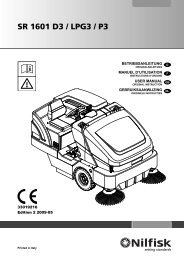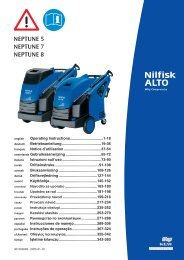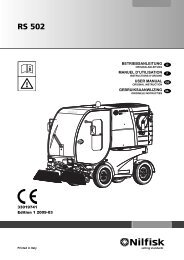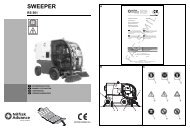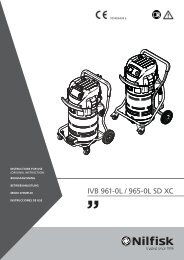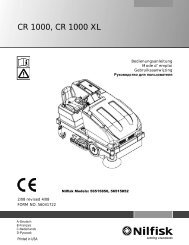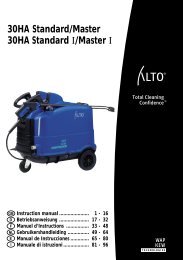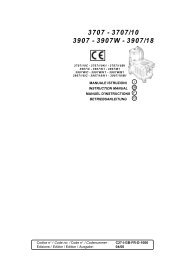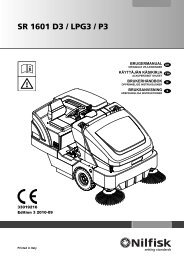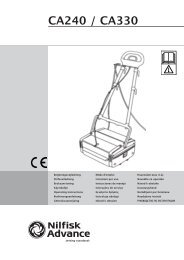A15 A15 X - XX A15 A - AX - AXX A15 DXX - Nilfisk PARTS
A15 A15 X - XX A15 A - AX - AXX A15 DXX - Nilfisk PARTS
A15 A15 X - XX A15 A - AX - AXX A15 DXX - Nilfisk PARTS
You also want an ePaper? Increase the reach of your titles
YUMPU automatically turns print PDFs into web optimized ePapers that Google loves.
<strong>A15</strong><br />
<strong>A15</strong> X - <strong>XX</strong><br />
<strong>A15</strong> A - <strong>AX</strong> - A<strong>XX</strong><br />
<strong>A15</strong> D<strong>XX</strong><br />
Tutti i diritti riservati / All rights reserved<br />
Tous droits réservés / Alle Rechte vorbehalten<br />
7.3 - Controllo tenute 7.3 - Seal inspection<br />
7.3 - Contrôle des étanchéités<br />
7.3 - Prüfung der Dichtungen<br />
- Verifica integrità tubazioni - Checking the condition of - Contrôle des tuyauteries - Prüfung der Schläuche auf<br />
the hoses<br />
Unversehrtheit<br />
A<br />
B<br />
Fig. 7.3.1<br />
Controllare l’integrità e il corretto<br />
fissaggio dei tubi “A” e “B”.<br />
In caso di lesioni, rotture o in<br />
caso di anomalo accoppiamento<br />
del tubo sui bocchettoni<br />
di raccordo, procedere alla<br />
sostituzione dei tubi.<br />
Quando vengono trattati materiali<br />
collosi, controllare le<br />
possibili occlusioni che possono<br />
intervenire lungo il tubo “B”, nel<br />
bocchettone e sul deflettore presente<br />
nella camera filtrante.<br />
Per la pulizia raschiare dall’esterno<br />
del bocchettone e<br />
rimuovere il materiale depositato<br />
come indicato in fig. 7.3.1.<br />
Make sure that connecting hose<br />
hoses “A” and “B” are in a good<br />
condition and correctly fixed.<br />
If the hoses are damaged, broken<br />
or badly connected to the<br />
unions, they must be replaced.<br />
When sticky materials are treated,<br />
check for possible clogging<br />
along hose “B”, in outlet and<br />
on the baffle in the filtering<br />
chamber.<br />
Scrape outside the outlet and<br />
remove the deposited waste as<br />
indicated in fig. 7.3.1.<br />
Il faut contrôler en particulier le<br />
bon état et la bonne fixation des<br />
tuyaux “A”et “B”.<br />
En cas de déchirures, ruptures<br />
ou d’accouplement anormal du<br />
tuyau sur les embouts de raccord,<br />
remplacer les tuyaux.<br />
En cas d’aspiration de matières<br />
collantes contrôler le long du<br />
tuyau “B”, dans l’embout et sur<br />
le déflecteur de la chambre<br />
filtrante car ils auront tendance<br />
à s’obstruer.<br />
Pour le nettoyage racler l’intérieur<br />
de l’embouchure et<br />
enlever la matière qui s’est<br />
déposée comme indiqué dans<br />
la fig. 7.3.1.<br />
Die Unversehrtheit und die korrekte<br />
Befestigung von Schläuchen<br />
“A” und “B” ist zu prüfen.<br />
Bei Beschädigungen, Brüchen<br />
oder falschem Anschluß der<br />
Schlauchs an die Anschlußstutzen<br />
sind die Schläuchen zu<br />
ersetzen.<br />
Wenn klebrige Materialien behandelt<br />
werden, sind mögliche<br />
Verschlußstellen zu suchen,<br />
die längs des Schlauchs “B”, im<br />
Stutzen und auf dem Leitblech<br />
in der Filterkammer vorliegen<br />
können.<br />
Zur Reinigung den Stutzen<br />
von außen abkratzen und das<br />
abgelagerte Material entfernen,<br />
so wie es in Abb. 7.3.1<br />
gezeigt ist.<br />
-26-



